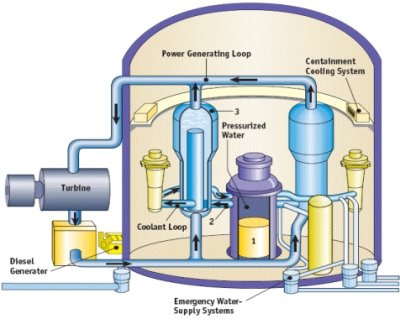Kewaunee Power Station, Wisconsin
Next Update: October 2009
Kewaunee Power Station
Net Generation and Capacity, 2007
Unit |
Net Capacity MW(e) |
Generation (Million Kilowatt Hours) |
Capacity Factor (Percent) |
Type | On Line Date |
License Expiration Date* |
| 1 | 556 | 4,625.806 | 95.0 | PWR | June 16,1974 | December 21, 2013 |
| *On August 14, 2008, the licensee submitted an application to the NRC to renew the license of the Kewaunee plant. The application seeks an extension to December 2033. PWR =pressurized light water reactors. Sources |
||||||
Description: The Kewaunee nuclear plant occupies a 900-acre site in Carlton, Wisconsin, about 35 miles southeast of Green Bay. Management of the site was consolidated with the Point Beach units. Kewaunee was the fourth nuclear plant built in Wisconsin, and the 44th built in the United States. In June 2005, the plant was acquired by Dominion from its previous owners, Wisconsin Public Service Corporation and Alliant Energy. The Virginia-based company owns the North Anna and Surry plants in its home state, and acquired one other out-of-state plant, Millstone (in Connecticut).
In 2004, the Kewaunee plant’s capacity factor (the ratio of the amount of electricity actually produced to the maximum potential output) was 81.8 percent. In 2005, it declined as a result of the unit being taken off-line to correct a discovered design weakness in the plant’s auxiliary feed-water system. The reactor was taken off-line on February 21, 2005, and returned to service in July after NRC concluded the problem has been corrected.
Kewaunee, Unit 1
Nuclear Steam System Supplier (NSSS Vendor) = Westinghouse Electric
Architect Engineer = Pioneer Services & Engineering
Owner = Dominion Generation
Operator (Licensee) = Dominion Generation
Pressurized-Water Reactor (PWR)
In a typical commercial pressurized light-water reactor (1) the reactor core generates heat, (2) pressurized-water in the primary coolant loop carries the heat to the steam generator, (3) inside the steam generator heat from the primary coolant loop vaporizes the water in a secondary loop producing steam, (4) the steam line directs the steam to the main turbine causing it to turn the turbine generator, which produces electricity. The unused steam is exhausted to the condenser where it is condensed into water. The resulting water is pumped out of the condenser with a series of pumps, reheated, and pumped back to the steam generator. The reactors core contains fuel assemblies which are cooled by water, which is force-circulated by electrically powered pumps. Emergency cooling water is supplied by other pumps, which can be powered by onsite diesel generators. Other safety systems, such as the containment cooling system, also need power.
 |
| © U.S. Nuclear Regulatory Commission |
Containment: According to the U.S. Nuclear Regulatory Commission, containment type for Kewaunee’s PWR is dry, ambient pressure.1
_________________________________________
1Dry, Ambient Pressure: a reactor containment design whose safety has been evaluated on the basis of having a dry air atmosphere at ambient pressure (0 psig) prior to the onset of a loss of coolant accident or steam pipe break. The containment design (concrete and steel tendons) must be able to take the full thermal and pressure stresses associated with the rapid energy release (steam) from a major pipe break.
Sources for Data in Table: Capacity, for purposes of this report, is the net summer capability as reported in Energy Information Administration (EIA) Form EIA-860, "Annual Electric Generator Report." Capacity Factor is a percentage calculation in which the maximum possible generation (based on net summer capability) is divided into the actual generation then multiplied by 100. Generation is the net electricity output reported by plant owners on Form EIA-906, “Power Plant Report.” Type of Unit: All U.S. commercial reactors currently in operation are one of two types: BWR (boiling water reactor) or PWR (pressurized light water reactor). The type, on-line date, and the license expiration date are published annually in Information Digest by the U.S. Nuclear Regulatory Commission.